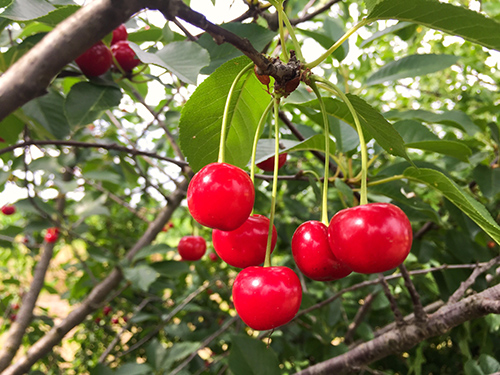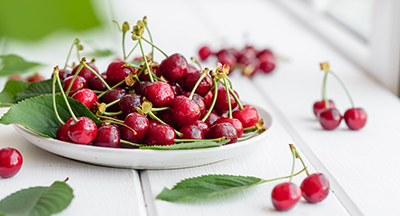Contents
Let us learn more about this delicious fruit before delving into the many health benefits of cherries. Anyone who has ever had something to do with cherries knows when they are ripe and delicious. A cherry tree in bloom and later filled with fruit adds a cheerful note of color to spring. Humans and birds benefit from this bounty.
Cherries have been eaten in Europe since the time of the Greeks and the Romans. Their delicate flavor and the pleasant sensation they leave explain why they are popular on the five continents, although the cherry tree does not do well in tropical areas.

Cherry Nutritional Facts
Traditionally, cherries have been considered sweet, pleasant fruits but of little nutritional or dietetic importance. However, it is now known that, while outstanding, it contains all of them in small amounts (except for vitamin B12). Of its fourteen percent sugars, the most important is fructose, which makes cherries appropriate for people with diabetes. Fats and proteins represent about one percent each.
Cherries contain small amounts of vitamins A, B, and E and all minerals and trace elements: calcium, phosphorous, magnesium, iron, sodium, potassium (the most abundant), zinc, copper, and manganese. However, cherries also contain small amounts of non-nutritive components:
ORGANIC ACIDS: Malic, succinic, and citric stimulate the digestive glands and blood purifiers. Light red cherries are richer in these acids than darker varieties. Sour cherries (Prunus cerasus L.) contain much more.
SOLUBLE VEGETABLE FIBER, which is formed primarily of pectin. One hundred grams of cherries provide ten percent of RDA (Recommended Daily Allowance) of vegetable fiber. This explains their gentle laxative and hypolipidemic (cholesterol-lowering) effects.
FLAVONOIDS give cherries diuretic, antioxidant, and anticarcinogenic properties. Among these flavonoids, ellagic acid is the most noteworthy. According to current research, this substance can neutralize carcinogenic substances, preventing healthy cells from becoming cancerous.
SALICYLIC ACID, the natural precursor to aspirin, acts as an anti-inflammatory and antirheumatic. It is in minimal amounts, around 2 mg per kg of cherries, but sufficient to have an effect.
Health Benefits of Cherries

Cherries are a pleasant, easy-to-eat fruit. They are particularly beneficial in the following cases:
OBESITY – The fact that cherries must be eaten one by one makes them effective in cases of obesity. Eating 360 calories of pastry only requires a few bites. On the other hand, consuming the same amount of calories as cherries means one-half kilo (about one pound). This may take fifteen minutes and result in a much greater feeling of fullness than after eating the sweet, eliminating the desire to continue eating. Cherries’ diuretic and depurant (purifying) effect, coupled with their virtual lack of sodium and fats, potentiates their weight loss effect and adds to the many health benefits of cherries.
DIABETES – Diabetics tolerate controlled amounts of cherries very well since half of their sugars are fructose. As in the case of all fruit treatments, those associated with cherries are not recommended for people with diabetes except under professional supervision.
DEPURANT TREATMENTS—According to Dr. Valnet, a distinguished French phytotherapist, one or two days of treatment with cherries is an excellent depurant for the body in general, facilitating the elimination of wastes and toxins.

CHRONIC DISORDERS—Cherry juice, particularly as a weekly treatment, is recommended for all types of chronic conditions, such as arthritis, gout, chronic rheumatism, arteriosclerosis, chronic constipation, autointoxication due to improper diet, chronic hepatopathy, cardiac failure, recovery from infectious disease, and cancer. The many health benefits of cherries are genuinely amazing.
Cherry Scientific Facts
- Scientific name: Prunus Avium L.
- Related species: Prunus cerasus L. (sour cherry).
- French: Cerise.
- Spanish: Cereza, guinda.
- German: Kirsche.
- Description: Fruit of the cherry tree of the botanical family Rosaceae that reaches a height of 20 meters. The fruit is a drupe about 2 cm in diameter whose color varies from light red to deep.
- Environment: Cherries are native to Central and Southern Europe, where they still may be found wild. Cherry cultivation has spread throughout temperate and cold regions of the world.
How to Use and Prepare Cherries

- FRESH – Cherries must be eaten one by one, chewing them well.
- CHERRY TREATMENT—This involves eating one-half kg of ripe cherries as the only food three or four times a day for two or three days. Those with delicate stomachs may boil them before eating. For a more substantial effect, one may drink several cups of tea by boiling 50 grams of cherry stems in a liter of water for five minutes.
- CULINARY RECIPES – Cherries fit perfectly into a variety of fruit pies, jams, and compotes
DISCLAIMER: All content on this website is presented solely for educational and informational objectives. Do not rely on the information provided as a replacement for advice, diagnosis, or treatment from a qualified medical expert. If you are pregnant, nursing, or have any preexisting medical concerns, talk to your doctor before using any herbal or natural medicines.
REFERENCES
- George D. Pamplona-Roger, M.D. “Encyclopedia of Foods and Their Healing Power.” George D. Pamplona-Roger, M.D. Encyclopedia of Foods and Their Healing Power. Trans. Annette Melgosa. Vol. 2. Chai Wan: Editorial Safeliz, 2005. 304, 305. Print. [Health benefits of cherries]
- Kelley, D. S., Rasooly, R., Jacob, R. A., Kader, A. A., & Mackey, B. E. (2010). Consumption of Bing sweet cherries lowers circulating concentrations of inflammatory biomarkers in healthy men and women. Journal of Nutrition, 140(8), 1481-1486. https://pubmed.ncbi.nlm.nih.gov/20573916/
- Kuehl, K. S., Perrier, E. T., Elliot, D. L., & Chesney, C. M. (2010). Efficacy of tart cherry juice in reducing muscle pain during running: a randomized controlled trial. Journal of the International Society of Sports Nutrition, 7, 17. https://jissn.biomedcentral.com/articles/10.1186/1550-2783-7-17
- Levers, K., Dalton, R., Galvan, E., Goodall, S., & Howatson, G. (2016). Effects of powdered Montmorency tart cherry supplementation on an acute bout of intense lower body strength exercise in resistance trained males. Journal of the International Society of Sports Nutrition, 13, 41.
